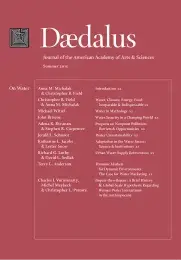Water Security in a Changing World
This essay defines the concept of water security and explores the implications of the eternal pursuit of it. I will describe how water security is perceived by wealthy and by poorer nations, the tensions that arise from these differing views, and how these tensions are being resolved in a world in which the geography of economics and power is changing rapidly. I outline a few iconic cases of how societies have built institutions and infrastructure to deal with both floods and droughts. The essay assesses the effects of changes in climate and land use systems, and the differing reactions to the new perception of “nonstationarity”: the idea that these systems are less predictable than they have historically been. The essay concludes with some reflections on the challenges of educating young people seized with passion for the issues of their generation but who may have difficulty taking a long view of water security. Many have been taught about the environmental ravages wrought by water infrastructure, but few understand how these same infrastructure and institutions underpin the water security that the United States has achieved. Similarly, we teach the next generation too little about the remarkable contributions of “thinking practitioners”: experts who are also involved in policy-making and planning–whose work underpins the food, water, and energy security of their societies.
The relationship of people to water is and has always been complex and contradictory. Ancient civilizations developed alongside rivers because of the services abundant and easily accessible water provided (such as irrigation, potable water, and transportation). Yet proximity to fickle rivers also meant that these civilizations were vulnerable to floods, droughts, and changing river courses. The challenge for civilizations both ancient and contemporary has been to confront this Faustian bargain and find balance–between too little and too much water on the one hand and between the financial and environmental costs and benefits of manipulating rivers, lakes, and aquifers on the other.
This essay addresses three contemporary aspects of this age-old quest. First, it describes what is meant by water security and outlines which aspects of water security keep forward-looking leaders awake at night. Second, the essay describes some successful efforts to manage the two ends of the water-security spectrum: droughts and floods. The essay concludes with some observations on the challenges that face policy-makers, scientists, and citizens in moving forward.
There are a few major concepts implicit in the idea of water security and its implementation challenges. First, water security is rooted in water’s contribution to the “good life.” An adequate supply of water of reasonable reliability and quality– for people, industry, agriculture, and energy–is essential for the well-being of societies. Second is the “Goldilocks” concept: that is, societies need just the right amount of water–not too little (few periods of scarcity) or too much (few periods of inundation). Third is the concept that building the institutions and infrastructure to provide water security involves financial and environmental trade-offs. Fourth and finally is the idea that context matters: people and governments choose to situate themselves at different points on the “risk/cost curve” depending on levels of development and social values.
According to the vast outpourings of the catastrophe-prediction industry, there is no end to the list of risks that threaten civilization and society today. However, issues of water security have moved up the priority lists for even the most sober prognosticators; three examples are worth mentioning.
The first is the national security establishment. One decade ago, the cogitations of national security bodies were largely concerned with two issues: nuclear proliferation and terrorism. Today, there is broad agreement that a range of environmental issues constitutes a third strand and that water looms large in these concerns. For example, in 2012, the U.S. National Intelligence Council produced a major report on the global trends that would frame “the alternative worlds of 2030.”1 One of these four dominant global trends was the water-energy-food nexus, and the Council suggested that “water may become a more significant source of contention than energy or minerals . . . at both the intrastate and interstate levels.”
The business community also expresses growing concern about water-related issues. Again, a decade ago, water would have been barely mentioned in the halls of Davos, the home of the World Economic Forum (WEF). The most recent WEF survey of global business leaders, however, shows that of the hundreds of identified risks to the global economy, not one has a higher combination of “likelihood” and “impact” than water.2
The third group expressing concern is citizens, as revealed in Globescan’s annual surveys of citizens in Brazil, Canada, China, France, Germany, India, Indonesia, Mexico, Nigeria, Turkey, the United Kingdom, and the United States. For every year since 2008, “shortages of freshwater” have been the highest-ranked environmental concern, above water pollution, depletion of natural resources, air pollution, loss of biodiversity, climate change, and automobile emissions (in descending order according to the most recent poll).3
. . .
